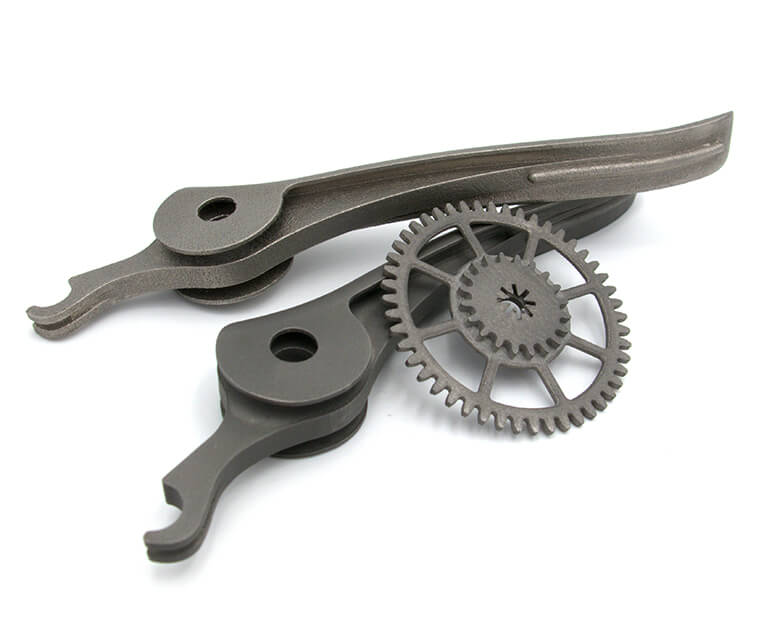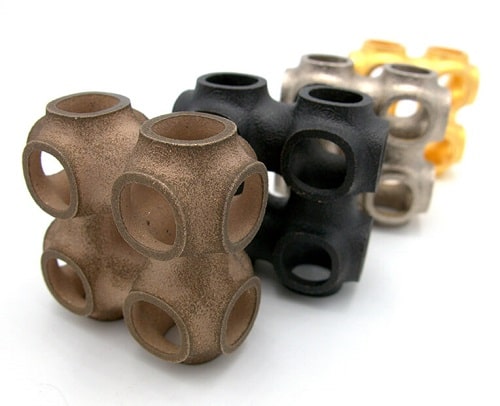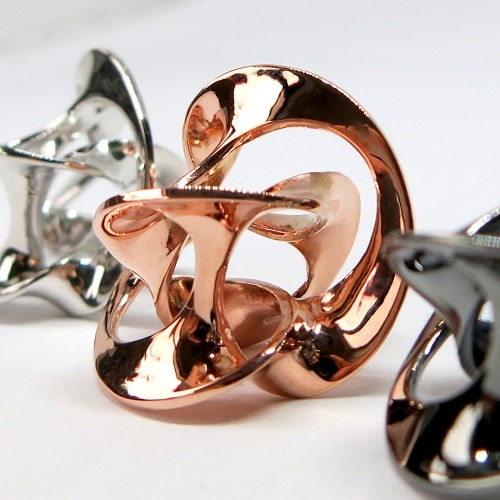All you need to know about our metal 3D printing service
Posted By Lucie Gaget on Aug 21, 2019 | 0 comments
Are you looking for a good and reliable metal 3D printing service? Well, our online 3D printing service offers a wide range of materials, including metal 3D printing materials. How could you start optimizing your metal production using additive manufacturing? What 3D printing technologies and materials are we offering? Why is using a 3D printing service for your metal part an advantage? Discover our online metal 3D printing service right now, and start to manufacture metal parts with us.
Don’t forget to download free our free ultimate metal 3D printing guide.
What are the benefits of metal 3D printing?
Yes, metal 3D printing has all the traditional benefits of additive manufacturing technology. Here are the main benefits of 3D printing metal.
- Work on new complex designs
3D printing is a great way to work on complex designs. By using 3D modeling software, you will be able to design any kind of project. When creating the design of your project for metal printing, you will have to pay attention to the design guidelines of the 3D printing material you choose. Following these guidelines is necessary to reach the best quality possible with your 3D prints.
- Mass-customization
Additive manufacturing is the best solution if you need to manufacture custom-made objects. You just have to modify your 3D design and print it as many times as you need. Mass-customization is a way to create your object but to adapt it to the customer, or to the patient if you are working in the medical sector.
- Topology optimization
Using 3D modeling software offers many advantages. You have total control over the object that will be manufactured. It is the perfect method to directly optimize the design of your project, by modifying the shape or adding structures such as lattices. 3D printing allows optimizing your part by reducing weight or work on the resistance of the part.
- Small volumes and lower cost
Additive manufacturing is a really convenient and cost-effective technique, especially if you need to manufacture short runs. Traditional manufacturing technique such as CNC machining.
- Speed, reduced assembly time
Additive manufacturing is the perfect way to give life to your project. You will improve your production by saving a lot of time both during product development and manufacturing processes. When it comes to assembly, metal 3D printing also has some benefits: some projects can be manufactured in only one part, avoiding the assembly process and allowing to create complex structure, impossible to build with traditional metal manufacturing techniques.
What are the metal 3D printing applications?
In order to understand exactly why implementing metal 3D printing in your business could be a big advantage for you, let’s see what are the possible applications of this cutting-edge technology. Aeronautic and aerospace are two fields currently developing their using of metal additive manufacturing. In these fields, in order to create the planes and rockets of the future, innovation is the key, and that is precisely what 3D printing is offering. This technology offers the possibility to create strong but lightweight parts thanks to new design opportunities like lattices structures.
The automotive industry is also starting to make the most of the advantages of metal 3D printing. Creating spare parts, lighter parts, or functional metal prototypes, has never been so easy.
The use of additive manufacturing is growing in the medical sector, and so is metal printing. Indeed, this metal technology is good to manufacture custom-made medical tools or even implants. Metal 3D printing can also help you to manufacture parts for the jewelry sector. This technology will definitely help you reach a new level of quality.
Start using a metal 3D printing service
Starting to use metal 3D printing can be a good solution for your business, but as you may know, buying industrial metal 3D printers is really expensive and desktop metal 3D printers are maybe not precise enough for your metal production.
Using a 3D printing service such as Sculpteo allows you to make the most of the whole catalog without investing all your money in expensive professional 3D printers. Affordable metal 3D printing with quality assurance is not a dream anymore, and Sculpteo is here to become your new manufacturing partner.
Our 3D printing service offers you a wide range of 3D printing materials from plastic to resin and metal. So, when it comes to metal, what are we offering? Let’s see all the metal 3D printing processes available through our website.
Our metal 3D printing technologies
-
Selective Laser Melting
Selective Laser Melting is a powder bed technology, developed to print metal alloys. How does it work? A laser beam sinters the material, layer by layer, according to the shape of your 3D model. Unlike technologies such as Direct Metal Laser Sintering, the powder is fully melted during the 3D printing process, thanks to an inert gas. Selective Laser Melting (or SLM) is a good printing technology for pure materials such as our Aluminium AlSi7Mg0.6.
While printing with a metal technology, you will often need to use supports to reinforce hangover and small angles in order to get a part perfectly 3D printed. These supports will be removed after the 3D printing process, once your part has cooled down. As this metal technology needs a higher temperature to fully melt the material, metal parts 3D printed with this technology have a longer cooling time than other 3D technologies.
This technology allows for creating really detailed parts and thin-walled objects. Keep in mind to check the design guidelines of the material you want to use to 3D print before sending your 3D model for printing.
Aluminium AISi7Mg0,6
If you want to use this 3D technology, you can print your part using our Aluminium AlSi7Mg0.6. This material is made from a fine metal powder composed mainly of aluminum (90%), silicon (7%) and magnesium (0.6%). This material has good mechanical properties and can be used for parts subject to high voltage. The main advantage of this metal material is its low weight.
You need to manufacture resistant industrial metal parts, like gears of propellers? Give this technology a try for your next project thanks to Sculpteo’s online metal 3D printing service.
-
Direct Metal Laser Sintering
Direct Metal Laser Sintering (or DMLS) is another powder bed technology, quite similar to Selective Laser Melting. A laser sinters the powder according to the 3D model you created. The difference with the SLM technology is the temperature: the process doesn’t require to fully melt the material. This way, the cooling time is shorter.
This 3D metal printing technology is perfect to manufacture strong parts for the automotive or aerospace industries. Indeed, just like SLM, this technology is good for highly resistant mechanical parts.
If you want to use this technology through our online 3D printing service, you can choose between two 3D printing materials: Stainless Steel 316L and Titanium 64AI-4V.
Stainless Steel 316L
Objects printed in 316L stainless steel at Sculpteo are created from fine metallic powder primarily composed of iron (66-70%), enriched with chrome (16-18%), nickel (11-14%), and molybdenum (2-3%). The material provides strong resistance against corrosion and is distinguished for its high ductility!
Titanium 64I-4V
3D objects printed using Sculpteo’s Titanium 6AI-4V are created from a fine metal powder composed mainly of Titanium (88-90%), Aluminum (5.50-6.5%) and Vanadium (3.50-4.50%).
This is grade 5, 6Al-4V Titanium. Titanium-based alloys are very hard and highly resistant to oxidation and acid. The melting point is extremely high (1660° C or 3260° F). It also has very low toxicity, which means it can be used in many ways. Titanium is perfect to manufacturing your functional metal parts.
-
Binder Jetting
Binder Jetting is a bit different from SLM and DMLS. This technique creates parts additively with a binding agent. The process uses a liquid binding agent deposited on the metal powder material thanks to an inkjet head. After the 3D printing process, a consolidation process is required to add the complete mechanical properties of the material and to avoid porosity.
This step is achieved in a hot isostatic pressing. The device will cure the object uniformly with heat and pressure. During the heating, the binding agent melts to let the powder form a homogeneous structure.
Binder Jetting is great to make jewelry, ornamental and decorative objects, thanks to its plating option, allowing to get an impressive result! The metal Binder Jetting process is the fastest and cheaper metal 3D printing technology. It will perfectly fit prototyping needs, ornamental and decorative objects or jewelry thanks to the plating options.
Stainless Steel 316
This Stainless Steel 216 material for Binder Jetting is perfect for small-size parts and has some good mechanical properties, like a strong resistance against corrosion and high-temperature resistance. From tooling to consumer products, this Binder Jetting material can handle complex shape.
Steel / Bronze 410SS/BR
The Steel / Bronze 420SS/BR material 3D printed with binder jetting is created from a fine stainless steel 420 powder. During the process, the material is infiltrated with bronze material to add strength and resistance to the object. In the end, the material is composed of a base of 60% stainless steel material and 40% bronze material.
This 3D printing material is particularly adapted to manufacturing ornaments and decorative objects, allowing to 3D print complex geometries.
-
Casting
Last, but not least, if you are planning on creating very precise 3D printed parts like jewelry or ornamental parts: Casting. Lost-wax casting is actually an alternative to additive and subtractive manufacturing to create multiple models from a first master model that will be used as a reference. The master model is the first 3D printed in wax.
Then a mold made in plaster is poured over this wax model, and once this plaster mold is ready, liquid metal is injected to replace the wax and create the finished product.
If you want to use this technology, you can choose between our Silver, Brass or Bronze.
Silver
Silver is principally used to create jewelry. Indeed, this material is perfect to create small parts, with great quality. The various finishing options offered by our Metal Casting technology will allow you to give life to amazing jewelry and decorative parts.
Brass
Sculpteo’s brass material is composed of 80% copper, 15% zinc and 5% tin. It can be raw, mirror polished or mirror polished and plated. Our brass models are assumed to encounter prolonged skin contact and will cause no harm in doing so. In fact, our brass models are particularly adept for jewelry creation!
Bronze
Our bronze material is composed of 90% copper and 10% tin. It comes in two finishes: Raw and Polished. Its surface is reddish – yellow and thus it is a perfect choice for decorative objects, jewelry, belt buckles, etc. Bronze is an affordable option when it comes to metal 3D printing!
Try out our instant quote and optimization tools
One of the greatest advantages of Sculpteo’s printing solution is that we are an online 3D printing service, you can easily upload your 3D files, as we accept more than 30 different file formats. Then, you will get an instant online quote for your 3D printed object! Once you have uploaded your 3D model, you can also use our optimization tools in order to improve your project, such as thickening fragile parts to avoid breaking.
3D printing is a real alternative to injection molding or CNC machining… Are you ready to try our online metal 3D printing service? Upload your model and receive your metal parts in a few days.
Check out our other technologies, HP Multi Jet Fusion, Selective Laser Sintering (SLS), Laser Cutting, etc.
Don’t forget to subscribe to our newsletter to get all our tips and pieces of advice about 3D printing.


 Connect with Google
Connect with Google Connect with Facebook
Connect with Facebook


